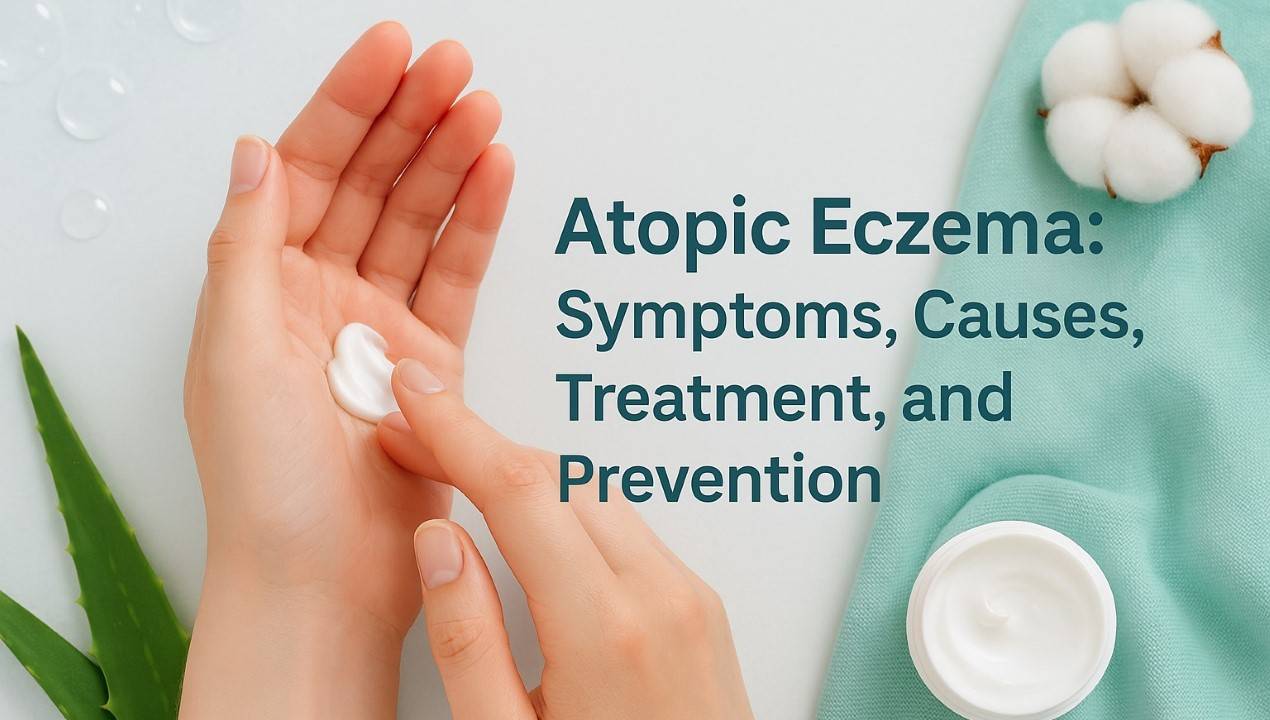Atopic eczema is a common skin condition that affects over 31 million Americans and millions more worldwide. This chronic inflammatory disease causes intense itching, redness, and discomfort that can significantly affect daily life. It can be itchy and frustrating, but daily hydration, mild products, and steering clear of triggers help.
This concise guide walks through symptoms, causes, diagnosis, treatments, complications, and prevention. Based on real-world experiences, it’s written in clear, friendly language everyone can follow. Ready to learn more?
What Is Atopic Eczema?
Atopic eczema, also known as atopic dermatitis, is a chronic skin condition that leads to red, itchy skin and sometimes minor bumps or blisters. It’s not contagious—you can’t catch it from anyone. I’ve noticed eczema flare-ups come and go, making skin feel worse at certain times. This condition often starts in babies or young children, but can affect adults too.
It’s part of a trio with asthma and hay fever, all sharing allergic roots. This skin problem can disrupt daily life, from keeping you awake at night to making you feel self-conscious about visible rashes. Gentle care can help your skin stay soothed and at ease. Let’s dive into the signs to watch for.
Symptoms of Atopic Eczema
How do you know if you have atopic eczema? Signs differ for everyone, yet these are the typical ones you’ll notice:
Common Signs to Watch For
Itchy skin: The itching can be intense, especially at night, making it hard to sleep. Scratching often worsens the problem.
- Red or inflamed skin: Patches may look red, darker, or discolored, depending on your skin tone, because of chronic skin inflammation.
- Rough, flaky skin: It may feel gritty because of excessive dryness.
- Minor bumps or blisters: These can form and may ooze fluid or crust over.
- Frequent scratching can harden the skin, turning it rough and leathery.
Where Symptoms Appear
In infants, atopic eczema commonly appears on the face, head, or torso. I’ve seen eczema in children appear on elbows, knees, or wrists as they grow. In adults, it’s common on the hands, neck, face, or even eyelids. These eczema symptoms can pop up anywhere, so paying attention to your skin is key. If you notice these signs, a doctor can help confirm if it is atopic eczema.
Impact on Daily Life
Living with itchy skin can be tough. It can disrupt sleep, make you feel distracted, or lower your confidence if rashes are visible. I’ve seen people struggle with this, but knowing the symptoms helps you act early. Keeping a diary of when symptoms worsen can help you spot patterns and manage flare-ups better.
Causes of Atopic Eczema
What causes atopic eczema? It’s a combination of genetics, environmental factors, and your body’s reactions. Let’s break it down:
Genetics and Family History
If your parents or siblings have atopic eczema, asthma, or skin allergies, you’re more likely to develop them. Genes affect your skin barrier function, which acts like a shield to keep moisture in and irritants out. A weak skin barrier lets water escape, leading to dry skin conditions, and allows irritants like dust or pollen to cause chronic skin inflammation. I like this explanation because it’s simple: your skin shield isn’t as strong as it should be.
Skin Barrier Dysfunction
Your skin is like a wall that protects your body. In atopic eczema, this wall has gaps, known as skin barrier dysfunction. This makes your skin dry and sensitive. Think of it like a leaky bucket—it can’t hold water well, so dry, itchy skin remedies are essential to keep your skin hydrated and protected.
Common Triggers for Flare-Ups
Certain things can spark eczema flare triggers, making symptoms worse. These vary, but common ones include:
- Strong soaps and cleaners can remove vital skin oils, making dryness worse.
- Weather changes: Cold, dry air in winter or hot, sweaty conditions in summer can trigger flare-ups.
- Food allergies: dairy, eggs, nuts, or wheat might cause allergic skin reactions in some people.
- Stress: Feeling anxious or overwhelmed can increase the need for itchy skin relief.
- Rough fabrics: wool, synthetic materials, or tight clothes can irritate sensitive skin.
- Airborne irritants like dust, animal fur, or pollen may trigger flare-ups.
Immune System Overreaction
Your immune system response might overreact to allergens like pollen, dust mites, or pet dander. This overreaction causes chronic skin inflammation, leading to red, itchy patches. I’ve seen how identifying eczema triggers and prevention strategies can make a vast difference in controlling atopic eczema. Logging your symptoms can uncover what’s setting them off.
Read more bout: How to Build Your Immunity System: 10 Easy Steps for a Stronger You
Diagnosis of Atopic Eczema
How do doctors confirm you have atopic eczema? They use simple steps to ensure it is atopic dermatitis and not another skin issue, like psoriasis or a fungal infection.
Physical Examination
A doctor will examine your skin, looking for signs like red, itchy skin, or dry skin conditions. I’ve seen doctors check rash locations, like elbows or knees, to identify eczema symptoms. They’ll note if the rash looks scaly, oozing, or typical of atopic eczema.
Medical and Family History
During diagnosis, doctors often check your medical and family backgrounds, especially for asthma, allergies, or hay fever, since these raise the risk of atopic eczema. They’ll also ask about triggers, like soaps, foods, or stress, to understand what causes your flare-ups.
Tests to Rule Out Other Conditions
Sometimes, doctors do tests to rule out other issues, like infections or skin allergies. A skin patch test can check for allergic skin reactions to substances like fragrances or metals. In rare cases, they might take a small skin sample to test for infections. These steps ensure an accurate diagnosis, so you get the right eczema treatment. Seeing a dermatologist can provide clarity if symptoms are unclear.
Complications of Atopic Eczema
If atopic eczema isn’t managed well, it can lead to complications. Here are some to watch for:
Skin Infections
Persistent scratching can damage skin, opening the door to infections. This can cause infections like impetigo, which makes the skin red, crusty, or pus-filled. I’ve seen infections worsen eczema flare-ups, so keeping skin clean and moisturized is crucial.
Read more about : Best All Natural Skin Care Routine: Organic Tips for Beauty
Sleep Problems
Severe nighttime itching can disrupt your sleep and leave you restless. Lack of sleep can make you tired, irritable, or stressed, which can trigger more flare-ups. Soothing creams or antihistamines can ease itchiness and improve sleep.
Emotional and Social Impact
Living with chronic skin inflammation can affect your confidence. Visible rashes on your face or hands might make you feel embarrassed or anxious. I’ve seen people benefit from talking to a counsellor or joining support groups to cope with the emotional toll.
Scarring or Skin Changes
Constant scratching can harden skin or cause scars. In some cases, skin may change color, becoming darker or lighter. Using topical treatments and moisturizers for eczema can prevent these changes and protect your skin barrier.
Treatment Options for Atopic Eczema
Managing atopic eczema is about soothing your skin and reducing flare-ups. Here are the latest treatments:
Moisturize Daily
Moisturizing is the cornerstone of eczema treatment. I’ve tested moisturizers for eczema, and thick, fragrance-free creams or ointments work best. Apply them at least twice a day, especially after bathing, to lock in moisture and support skin barrier repair. Look for products with ceramides or hyaluronic acid.
Gentle Cleansing
Harsh soaps can worsen atopic dermatitis symptoms. Use mild, fragrance-free cleansers designed for eczema-safe skincare. Take short, lukewarm showers—hot water dries out skin. Use a soft towel to gently blot your skin dry.
Medicated Treatments
For severe eczema symptoms, your doctor might recommend:
- Topical corticosteroids: These creams reduce skin inflammation and itching. Use as directed to avoid side effects.
- Non-steroid creams: calcineurin inhibitors (e.g., tacrolimus) help without steroids.
- Antihistamines: These ease nighttime itching, helping you sleep.
Wet Wrap Therapy
For bad eczema flare-up treatment, apply moisturizer or topical treatments, then wrap the area in a damp cloth, followed by a dry one. This helps the cream soak in. I’ve seen this work well for dermatitis in children. Ask your doctor for guidance.
Biologic Therapies
New biologic therapies, like diplomacy, target the eczema and immune system connection. Reserved for tough eczema cases that don’t respond to other treatments. I’m eager about these advancements; they’re helping so many people!
Preventing Atopic Eczema Flare-Ups
Preventing eczema flare-ups is key. Here are practical tips:
Skincare Routine
Use moisturizers for eczema daily. Bathe with gentle cleansers and apply cream right after for dry skin management. I like this routine because it’s simple and effective.
Soft Clothes
Wear cotton, not wool, to avoid allergic skin reactions. Wash new clothes to remove chemicals.
Stress Management
Stress can trigger eczema flare-ups. I like deep breathing or a short walk—it helps! Good sleep calms skin.
Weather Watch
Cold or hot weather can worsen atopic eczema. Use a humidifier in winter and stay cool in summer.
Food Awareness
Foods like dairy might cause skin allergies. Track your diet and test for allergies if needed.
Atopic Eczema in Babies
Atopic eczema is common in babies, often on the cheeks or scalp. Use baby-safe moisturizers for eczema, soft cotton clothes, and consult a pediatrician for dermatitis treatment.
Living Well with Atopic Eczema
Atopic eczema is tough, but manageable. Join support groups, see a dermatologist, and stay positive. Eczema-safe skincare makes a big difference.
FAQs About Atopic Eczema
What Triggers Atopic Eczema?
Triggers include soaps, stress, weather, food, or wool. Track eczema flare triggers to avoid flare-ups.
What Is the 3-Minute Rule for Eczema?
Apply moisturizers for eczema within three minutes of bathing for skin barrier repair. I’ve tested it!
What’s the Difference Between Eczema and Atopic Eczema?
Eczema refers to itchy skin issues; atopic eczema is a long-term form linked to allergies and fragile skin.
How Do You Get Rid of Atopic Eczema?
You can’t cure atopic eczema, but moisturizing, topical controversy, and avoiding triggers help. See a doctor for eczema treatment options.
Final Thoughts
Atopic eczema can be challenging, but you’re not alone. Moisturize daily, avoid triggers, and try natural eczema solutions. I’ve seen these tips help—try them and share your story in the comments!



